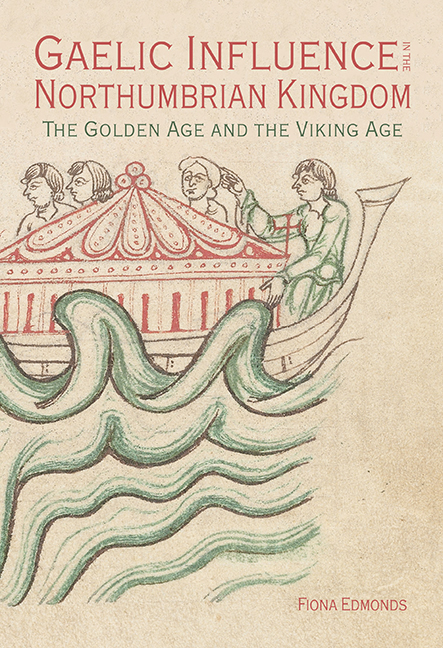Book contents
- Frontmatter
- Contents
- List of Illustrations
- Acknowledgements
- List of Abbreviations
- Preface: An Eventful Voyage
- 1 Concepts and Historiography of the Northumbrian and Gaelic Worlds: Medieval to Modern
- 2 Exiles and Emperors: Gaelic-Northumbrian Political Relations in the Golden Age
- 3 Fragmentation and Opportunity: From the Eighth Century to the Viking Age
- 4 Pathways through the Past: Routes between the Gaelic World and the Northumbrian Kingdom
- 5 A Golden Age of Ecclesiastical Contacts
- 6 Saints and Seaways in the Viking Age
- 7 Medieval Multilingualism: Gaelic Linguistic Influence in the Northumbrian Kingdom
- 8 Movement and Material Culture in the Northumbrian and Gaelic Worlds
- Conclusion: Individuals and Influences
- Bibliography
- Index
- STUDIES IN CELTIC HISTORY
Conclusion: Individuals and Influences
Published online by Cambridge University Press: 28 February 2020
- Frontmatter
- Contents
- List of Illustrations
- Acknowledgements
- List of Abbreviations
- Preface: An Eventful Voyage
- 1 Concepts and Historiography of the Northumbrian and Gaelic Worlds: Medieval to Modern
- 2 Exiles and Emperors: Gaelic-Northumbrian Political Relations in the Golden Age
- 3 Fragmentation and Opportunity: From the Eighth Century to the Viking Age
- 4 Pathways through the Past: Routes between the Gaelic World and the Northumbrian Kingdom
- 5 A Golden Age of Ecclesiastical Contacts
- 6 Saints and Seaways in the Viking Age
- 7 Medieval Multilingualism: Gaelic Linguistic Influence in the Northumbrian Kingdom
- 8 Movement and Material Culture in the Northumbrian and Gaelic Worlds
- Conclusion: Individuals and Influences
- Bibliography
- Index
- STUDIES IN CELTIC HISTORY
Summary
In this book, I have followed early medieval travellers as they plied the seas and traversed the roads between the Gaelic-speaking world and the Northumbrian kingdom. The prime movers included kings and churchmen of the stature of King Oswald and St Adomnán, as well as the nameless yet well-travelled individual buried by the Roman road at Carronbridge in Nithsdale. The journeys of individuals, families and communities lie behind the rather abstract concept of ‘Gaelic influence’. I have demonstrated that Gaelic-speaking and Gaelic–Scandinavian groups had a long-lasting and dynamic impact on the Northumbrian kingdom, not only during its heyday, but most especially during its disintegration. In this final section, I draw out themes that cut across the various types of source material, and I highlight topics that would benefit from future research.
The intrepid individuals lacked a map to guide them in their travels: landmarks, seamarks, place-names and personal guides took on a greater importance than they have today. By the eleventh century, when Gaelic influence was reaching its peak in the west and north of the former kingdom, a monk in the distant south of England was sketching out the basis of a mappa mundi. This work of 1025–50 is valuable since it contains the first reasonably realistic medieval representation of Britain and Ireland although – like many modern maps – it is no objective representation of the world. In common with many mappae mundi, Jerusalem appears in the centre and Britain and Ireland on the edge, surrounded by ocean. This perception was informed by classical concepts and models (this map potentially having been based on a Roman original), as well as the significance of the biblical lands to ecclesiastical scholars. The Northumbrian kingdom is nowhere to be seen; Hadrian’s Wall remains the dominant feature of the region, and Cumbria gets an unexpected mention. Nonetheless, some aspects of the map chime with the discussion of travel in this volume. Islands are remarkably prominent – indeed northern Britain seems to evaporate into a great number of them – and the Isle of Man takes up most of the Irish Sea. The Island has emerged as a key link between the Northumbrian kingdom and the Gaelic world, despite its underrepresentation in texts.
- Type
- Chapter
- Information
- Gaelic Influence in the Northumbrian KingdomThe Golden Age and the Viking Age, pp. 219 - 222Publisher: Boydell & BrewerPrint publication year: 2020



